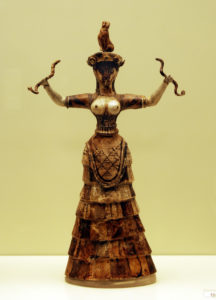Now that In the Shadow of the Bull will be released this summer, I thought I should talk a little bit about the culture of ancient Crete.
Although it is called the Minoan Era, that is a misnomer. Minos was a mythical king mentioned in Greek stories from Classical Greece, many years later.
What we do know is that this sophisticated society flourished in the Bronze Age, only to be destroyed about 1459 B.C.E, The volcano on the island now called Santorini blew, sending ash as far away as Turkey., and causing massive damage to Crete. Some archaeologists discuss signs of rebuilding but the Achaeans, the Greeks from the Mainland, were able to take advantage and occupy the island.
The iconic statuettes from Bronze Age Crete are of women (priestesses probably although some scholars claim they are the Goddess) with snakes twining up their arms and around their waists. Snakes were sacred in this Bronze Age religion.

http://en.wikipedia.org/wiki/Snake_Goddess
The shedding of their skins was a symbol of rebirth and regeneration. One of the resources I read said that the snakes were allowed to live in the houses. (I am not sure how she knows that.) If so, I’m sure that the presence of the snakes kept down the mice.
Currently Crete does not have native venomous snakes and it is thought that there no venomous snakes in Crete during the Bronze Age either. So, of course I had to wonder if the asp was ever imported from Egypt.
(I think everyone knows that Cleopatra is supposed to have committed suicide with an asp. According to my research, however, it was a mixture of poisons including opium and wolfsbane. But I digress.)
The prevalence of women in the artwork, not just statuary but also the mosaics, have lent support to the theory that women enjoyed a high status in this society. It is theorized that the religion featured a Goddess as well as less important Gods. Several were transported virtually unchanged to the pantheon of Hellenic Greece.

